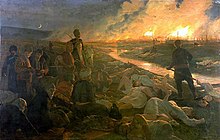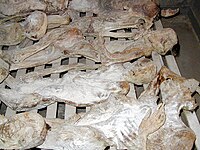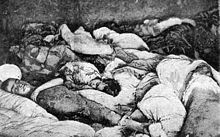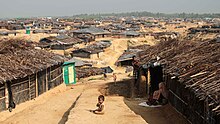Ethnic cleansing by the Turks in Bulgaria during the Batak massacre.
Although ethnic cleansing has occurred long through history, the term was initially used by the perpetrators during the Yugoslav Wars and cited in this context as a euphemism akin to that of Nazi Germany's "Final Solution",
by the 1990s, and gained widespread acceptance due to journalism and
the media's heightened use of the term in its generic meaning.
Etymology
An antecedent to the term is the Greek word andrapodismos (Greek: ανδραποδισμός; lit. "enslavement"), which was used in ancient texts to describe atrocities that accompanied Alexander the Great's conquest of Thebes in 335 BC. In the early 1900s, regional variants of the term could be found among the Czechs (očista), the Poles (czystki etniczne), the French (épuration) and the Germans (Säuberung). A 1913 Carnegie Endowment report condemning the actions of all participants in the Balkan Wars contained various new terms to describe brutalities committed toward ethnic groups.
Massacres of Poles in Volhynia in 1943. Most Poles of Volhynia (now in Ukraine) had either been murdered or had fled the area.
During World War II, the euphemism čišćenje terena ("cleansing the terrain") was used by the Croatian Ustaše to describe military actions in which non-Croats were purposely killed or otherwise uprooted from their homes. Viktor Gutić,
a senior Ustaše leader, was one of the first Croatian nationalists on
record to use the term as a euphemism for committing atrocities against Serbs. The term was later used in the internal memorandums of Serbian Chetniks in reference to a number of retaliatory massacres they committed against Bosniaks and Croats between 1941 and 1945. The Russian phrase очистка границ (ochistka granits;
lit. "cleansing of borders") was used in Soviet documents of the early
1930s to refer to the forced resettlement of Polish people from the
22-kilometre (14 mi) border zone in the Byelorussian and Ukrainian SSRs. This process was repeated on an even larger scale in 1939–41, involving many other groups suspected of disloyalty towards the Soviet Union. During The Holocaust, Nazi Germany pursued a policy of ensuring that Europe was "cleansed of Jews" (Judenrein).
After the Allies' victory, transferrals "to Germany of German
populations, or elements thereof, remaining in Poland, Czechoslovakia
and Hungary", were undertaken
to create ethnically homogeneous nations with shifted borders that
often included areas where previously Germans had constituted a
majority.
In its complete form, the term appeared for the first time in the Romanian language (purificare etnică) in an address by Vice Prime Minister Mihai Antonescu to cabinet members in July 1941. After the beginning of the invasion of the USSR, he concluded: “I do not know when the Romanians will have such chance for ethnic cleansing." In the 1980s, the Soviets used the term "ethnic cleansing" to describe the inter-ethnic violence in Nagorno-Karabakh.
At around the same time, the Yugoslav media used it to describe what
they alleged was an Albanian nationalist plot to force all Serbs to
leave Kosovo. It was widely popularized by the Western media during the Bosnian War (1992–95). The first recorded mention of its use in the Western media can be traced back to an article in The New York Times dated 15 April 1992, in a quote by an anonymous Western diplomat.
Synonyms include ethnic purification.
Definitions
Rwandan Genocide Murambi bodies
The Final Report of the Commission of Experts established pursuant to Security Council Resolution 780
defined ethnic cleansing as "a purposeful policy designed by one ethnic
or religious group to remove by violent and terror-inspiring means the
civilian population of another ethnic or religious group from certain
geographic areas".
In its previous, first interim report it noted, "[b]ased on the many
reports describing the policy and practices conducted in the former Yugoslavia,
[that] 'ethnic cleansing' has been carried out by means of murder,
torture, arbitrary arrest and detention, extra-judicial executions, rape
and sexual assaults, confinement of civilian population in ghetto
areas, forcible removal, displacement and deportation of civilian
population, deliberate military attacks or threats of attacks on
civilians and civilian areas, and wanton destruction of property. Those
practices constitute crimes against humanity and can be assimilated to specific war crimes. Furthermore, such acts could also fall within the meaning of the Genocide Convention."
The official United Nations definition of ethnic cleansing is "rendering an area ethnically homogeneous by using force or intimidation to remove from a given area persons of another ethnic or religious group".
As a category, ethnic cleansing encompasses a continuum or spectrum of policies. In the words of Andrew Bell-Fialkoff:
[E]thnic cleansing [...] defies easy definition. At one end it is virtually indistinguishable from forced emigration and population exchange while at the other it merges with deportation and genocide. At the most general level, however, ethnic cleansing can be understood as the expulsion of a population from a given territory.
Terry Martin
has defined ethnic cleansing as "the forcible removal of an ethnically
defined population from a given territory" and as "occupying the central
part of a continuum between genocide on one end and nonviolent
pressured ethnic emigration on the other end".
In reviewing the International Court of Justice (ICJ) Bosnian Genocide Case in the judgement of Jorgic v. Germany on July 12, 2007 the European Court of Human Rights quoted from the ICJ ruling on the Bosnian Genocide Case to draw a distinction between ethnic cleansing and genocide:
The term 'ethnic cleansing' has frequently been employed to refer to the events in Bosnia and Herzegovina which are the subject of this case ... [UN] General Assembly resolution 47/121 referred in its Preamble to 'the abhorrent policy of "ethnic cleansing", which is a form of genocide', as being carried on in Bosnia and Herzegovina. ... It [i.e., ethnic cleansing] can only be a form of genocide within the meaning of the [Genocide] Convention, if it corresponds to or falls within one of the categories of acts prohibited by Article II of the Convention. Neither the intent, as a matter of policy, to render an area "ethnically homogeneous", nor the operations that may be carried out to implement such policy, can as such be designated as genocide: the intent that characterizes genocide is "to destroy, in whole or in part" a particular group, and deportation or displacement of the members of a group, even if effected by force, is not necessarily equivalent to destruction of that group, nor is such destruction an automatic consequence of the displacement. This is not to say that acts described as 'ethnic cleansing' may never constitute genocide, if they are such as to be characterized as, for example, 'deliberately inflicting on the group conditions of life calculated to bring about its physical destruction in whole or in part', contrary to Article II, paragraph (c), of the Convention, provided such action is carried out with the necessary specific intent (dolus specialis), that is to say with a view to the destruction of the group, as distinct from its removal from the region. As the ICTY has observed, while 'there are obvious similarities between a genocidal policy and the policy commonly known as 'ethnic cleansing' (Krstić, IT-98-33-T, Trial Chamber Judgment, 2 August 2001, para. 562), yet '[a] clear distinction must be drawn between physical destruction and mere dissolution of a group. The expulsion of a group or part of a group does not in itself suffice for genocide.'
— ECHR quoting the ICJ.
As a crime under international law
There is no international treaty that specifies a specific crime of ethnic cleansing. However, ethnic cleansing in the broad sense—the forcible deportation of a population—is defined as a crime against humanity under the statutes of both International Criminal Court (ICC) and the International Criminal Tribunal for the Former Yugoslavia (ICTY).
The gross human-rights violations integral to stricter definitions of
ethnic cleansing are treated as separate crimes falling under public
international law of crimes against humanity and in certain circumstances genocide.
There are however situations, such as the expulsion of Germans after World War II, where ethnic cleansing has taken place without legal redress. Timothy V. Waters argues therefore that similar ethnic cleansing could go unpunished in the future.
Genocide
Armenian Genocide victims
Academic discourse considers both genocide
and ethnic cleansing to exist in a spectrum of assaults on nations or
religio-ethnic groups. Ethnic cleansing is similar to forced deportation
or population transfer whereas genocide is the intentional murder of
part or all of a particular ethnic, racial, religious, or national
group. While ethnic cleansing and genocide may share the same goal and
the acts used to perpetrate both crimes may often resemble each other,
ethnic cleansing is intended to displace a persecuted population from a
given territory, while genocide is intended to destroy a population.
Some academics consider genocide as a subset of "murderous ethnic cleansing".
Thus, these concepts are different, but related, as Norman Naimark
writes: "literally and figuratively, ethnic cleansing bleeds into
genocide, as mass murder is committed in order to rid the land of a
people".
William Schabas adds, "Ethnic cleansing is also a warning sign of
genocide to come. Genocide is the last resort of the frustrated ethnic
cleanser."
As a military, political and economic tactic
As
a tactic, ethnic cleansing has a number of systemic impacts. It enables
a force to eliminate civilian support for resistance by eliminating the
civilians—recognizing Mao Zedong's dictum that guerrillas among a civilian population are fish in water, it removes the fish by draining the water. When enforced as part of a political settlement, as happened with the forced resettlement of ethnic Germans to the new Germany after 1945, it can contribute to long-term stability. Some individuals of the large German population in Czechoslovakia and prewar Poland had encouraged Nazi jingoism before the Second World War, but this was forcibly resolved. It thus establishes "facts on the ground"—radical demographic changes which can be very hard to reverse.
Silent ethnic cleansing
The term silent ethnic cleansing was coined in the mid-1990s by some observers of the Yugoslav Wars.
Apparently concerned with Western media representations of atrocities
committed in the conflict—which generally focused on those perpetrated
by the Serbs—atrocities committed against Serbs were dubbed "silent" on the grounds that they did not receive adequate coverage.
Instances
In many cases where accusations of ethnic cleansing have circulated,
partisans have fiercely disputed such an interpretation and the details
of the events which have been described as ethnic cleansing by academic
or legal experts. This often leads to the promotion of vastly different
versions of the event in question.
Armenia, 1914-1923
During the beginning of World War I in 1914, following defeats by the Russian army due to a lack of proper leadership and preparation, the government of the Ottoman Empire banished all Armenian soldiers in desperation based on the belief that they were the ones to blame for the defeats.
What began as a military tactic, eventually, lead to a brutal genocide
of the ethnic Armenian population that was living in Turkey beginning
with the execution of male Armenians and eventually ending with the
forced deportation of Armenian women and children.
It is estimated that around 800,000 to 1 million ethnic Armenians
living in Turkey were either executed or forcibly deported during World
War 1.
The Armenian Genocide has been recognized as a genocide by most
scholars and nations due to its deliberate targeting of ethnic Armenians
and the brutal fashion in which it was implemented and it has also been
viewed as an act of Ethnic Cleansing due to the Ottoman government's
desire to remove a specific ethnicity from its territory.
Germany, 1933-1945
Recognized as one of the most extreme cases of ethnic cleansing in history, the Holocaust was the Nazi Regime's mass murder of about 6 million Jews during World War II. Accomplished in stages, the Holocaust began with legislation to remove Jews from German society before World War II. Concentration and extermination camps
were then created to incarcerate and execute the millions of Jews who
were living in Germany and most of them were either shot, killed in gas chambers, or worked to death.
Killing approximately 90 percent of the Jews who were living in Poland
and 87 percent of the Jews who were living in Germany and Austria, the
Nazi Regime's motives, the horrific ways in which its victims were
executed, and the number of ethnic Jews who were murdered make the
Holocaust one of the clearest and least disputed cases of ethnic
cleansing in history.
Eastern Europe, 1944-1949
A ceremony marking the 16th anniversary of Operation Storm, which resulted in the expulsion of more than 200,000 ethnic Serbs from Croatia.
Following
World War II, from 1944 to 1949, approximately 14 million Germans were
forcibly removed from Central and Eastern Europe, from areas where
Germans had been a minority since the Middle Ages, as well as from specific regions, particularly, from present-day Czechia, present-day western and north-eastern Poland and the Kaliningrad Oblast where Germans constituted the vast majority of the population.
Although the removal primarily consisted of a forced migration,
approximately 2 million Germans were killed during the migration either
by starvation, poor weather conditions, or beatings and murder at the
hands of troops and mobs that consisted of Russians, Poles, Czechs or
other locals.
The ethnic cleansing of Germans in Eastern and Central Europe was an
outpouring of the hatred and negative sentiment towards Germans that was
a result of the inhumane acts which the Nazi regime committed during
the course of World War II and it was also justified by the desire of
European governments to turn their countries into more ethnically
homogenous nation-states, and to this end, the post-war borders of Poland comprised close to a quarter of Germany's pre-war territory.
Bosnia & Herzegovina, 1990-1993
During the Bosnian War
which lasted from 1992-1995, many civilians fell victim to the ethnic
cleansing that was committed by Bosnian Serbs, Bosnian Croats, and
Bosnian Muslims. All three ethnic groups sought to create their own
ethnically homogenous territories within Bosnia and Herzegovina and as a
result of the conflict, about 2,700,000 people within the country were
displaced.
The methods which were used during the Bosnian ethnic cleansing
campaigns included "murder, torture, arbitrary arrest and detention,
extra-judicial executions, rape and sexual assaults, the confinement of
civilian populations in ghetto areas, the forcible removal, displacement
and deportation of civilian populations, deliberate military attacks or
threats of attacks on civilians and civilian areas, and the wanton
destruction of property".
Creating the largest flow of internally displaced citizens since World
War II, the ethnic cleansing that occurred in Bosnia and Herzegovina
during the 1990s is still apparent in the ethnically homogeneous regions
of Bosnian Serbs, Croats, and Muslims that exist in modern day Bosnia
with politicians attempting to obstruct the undoing of the ethnic
cleansing that took place during the war.
Georgia, 1992-1993
From 1992 through 1993, during the Georgian-Abkhaz conflict, the armed Abkhaz separatist insurgency implemented a campaign of ethnic cleansing against the large population of ethnic Georgians.
This was actually a case in which a minority was trying to drive out a
majority, rather than a case in which a majority was trying to drive out
a minority, because Georgians were the single largest ethnic group in
pre-war Abkhazia, with a 45.7% plurality as of 1989.
As a result of this deliberate campaign of ethnic cleansing by the
Abkhaz separatists, more than 250,000 ethnic Georgians were forced to
flee, and approximately 30,000 people were killed in incidents that
involved massacres and expulsions. This was recognized as ethnic cleansing by Organization for Security and Co-operation in Europe conventions, and was also mentioned in UN General Assembly Resolution GA/10708.
Rohingya refugees from Myanmar, March 2017
Myanmar, 2016-Present
Since 2016, Myanmar's
military-dominated government has forced over 620,000 ethnic Rohingya
who live in the Rakhine state of northwest Myanmar to flee to
neighboring Bangladesh.
The Rohingya are a group of about 1 million Muslims who live in the
Rakhine state but they are denied citizenship and considered illegal
immigrants and as a result, they have been subjected to persecution and
discrimination by the government of Myanmar and Buddhist nationalists.
Myanmar's government has cracked down on the Rohingya people and forced
them to migrate to Bangladesh through violent actions, with rape,
arson, and murder being reported.
UN human rights chief Zeid Ra'ad Al Hussein has stated that “The
situation seems to be a textbook example of ethnic cleansing” while
governments across the world have called on Myanmar's government to take
control of the situation and stop the ethnic cleansing of the Rohingya
people.
Criticism of the term
Gregory Stanton, the founder of Genocide Watch,
has criticised the rise of the term and its use for events that he
feels should be called "genocide": because "ethnic cleansing" has no
legal definition, its media use can detract attention from events that
should be prosecuted as genocide. Because of widespread acceptance after media influence, it has become a word used legally, but carries no legal repercussions.
In 1992, the German equivalent of "ethnic cleansing" (German: Ethnische Säuberung) was named German Un-Word of the Year by the Gesellschaft für deutsche Sprache due to its euphemistic, inappropriate nature.







